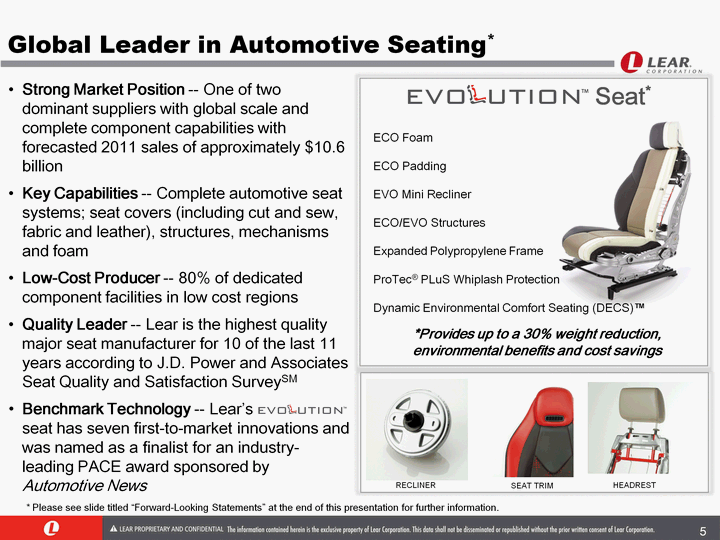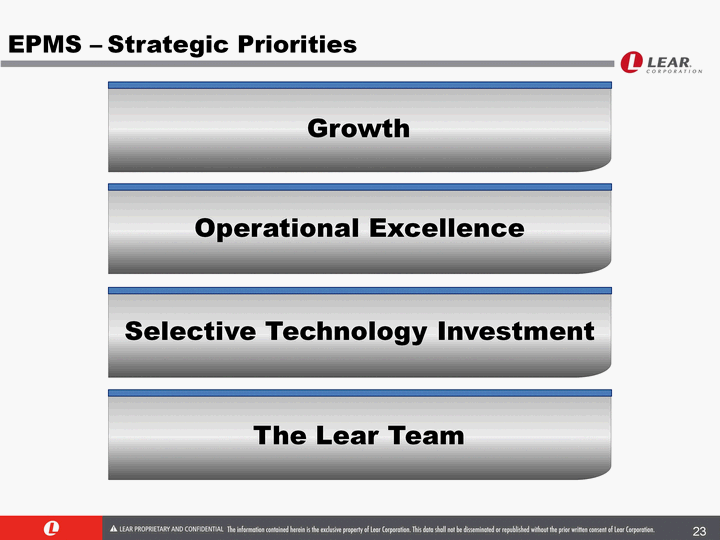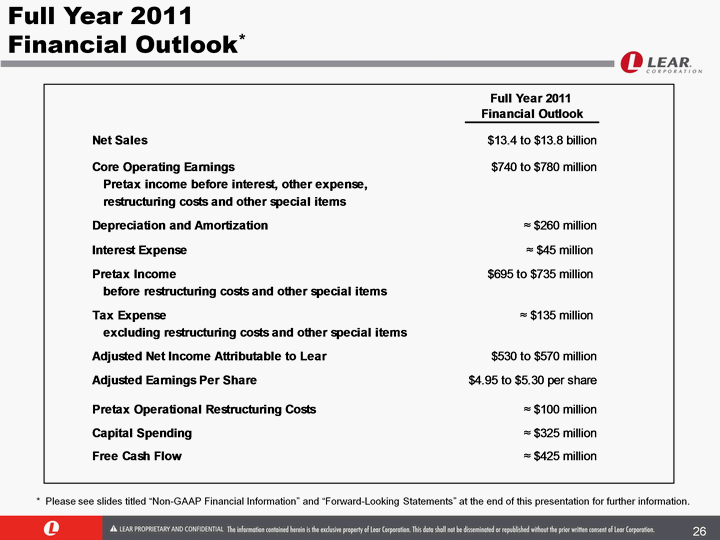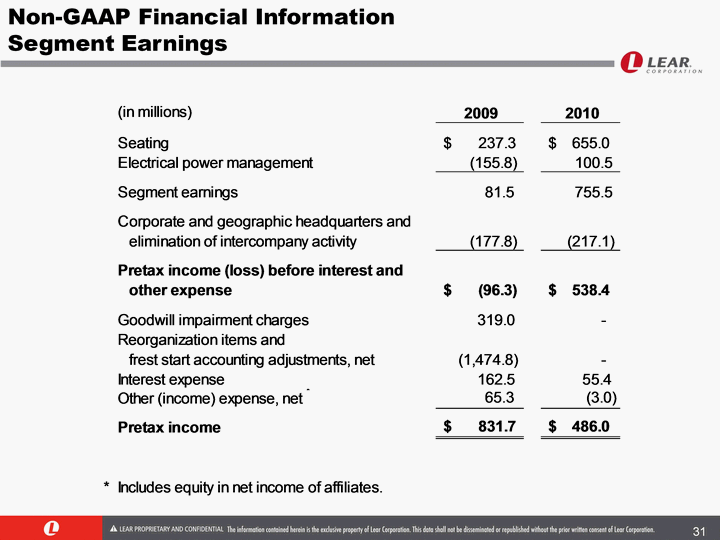Attached files
| file | filename |
|---|---|
| 8-K - FORM 8-K - LEAR CORP | k50724e8vk.htm |
Exhibit 99.1

| Frankfurt Auto Show Investor Conference September 13, 2011 |

| Agenda Lear Business Overview Matt Simoncini, President and CEO Electrical Power Management Systems Ray Scott, SVP and President EPMS 2011 Financial Outlook Jason Cardew, Interim CFO Summary Matt Simoncini, President and CEO Q & A 2 |

| 3 Lear Business Overview |

| 4 Present State of the Business* Leading Tier 1 global automotive supplier Strong global position and low-cost footprint Leader in product quality, customer service and innovation Diversified sales and customer base serving all of the world's major automakers Very strong balance sheet, with $1.8 billion in cash and no debt maturities until 2018 Positive operating and financial momentum Lear Is Extremely Well Positioned To Capitalize On Global Industry Growth * Please see slide titled "Forward-Looking Statements" at the end of this presentation for further information. |

| Strong Market Position -- One of two dominant suppliers with global scale and complete component capabilities with forecasted 2011 sales of approximately $10.6 billion Key Capabilities -- Complete automotive seat systems; seat covers (including cut and sew, fabric and leather), structures, mechanisms and foam Low-Cost Producer -- 80% of dedicated component facilities in low cost regions Quality Leader -- Lear is the highest quality major seat manufacturer for 10 of the last 11 years according to J.D. Power and Associates Seat Quality and Satisfaction SurveySM Benchmark Technology -- Lear's seat has seven first-to-market innovations and was named as a finalist for an industry- leading PACE award sponsored by Automotive News Global Leader in Automotive Seating* ECO Foam ECO Padding EVO Mini Recliner ECO/EVO Structures Expanded Polypropylene Frame ProTec(r) PLuS Whiplash Protection Dynamic Environmental Comfort Seating (DECS)(tm) 5 Seat* *Provides up to a 30% weight reduction, environmental benefits and cost savings RECLINER HEADREST SEAT TRIM * Please see slide titled "Forward-Looking Statements" at the end of this presentation for further information. |

| HIGH-POWER WIRE HARNESS SOLID STATE SMART JUNCTION BOX(tm) TRADITIONAL WIRE HARNESS Strong Market Position -- One of four suppliers with global capability in both traditional and high-power electrical power management systems with forecasted 2011 sales of approximately $3.0 billion Key Capabilities -- Traditional electrical distribution systems, emerging high-power systems and related components including connectors, smart junction boxes and battery chargers Low-Cost Producer -- 80% of component facilities in low cost regions Quality Leader -- Outstanding program management capabilities support thousands of design changes per year with world class quality Benchmark Technology -- Lear has won high-power and hybrid business with BMW, Coda, Daimler, Fisker, General Motors, Land Rover, Nissan, Renault and Volkswagen Sales growth opportunity with improving margins Additional consumer demand for features & functionality Greater electrification and signal management of alternative powertrain design 6 Strong Global Position in Automotive Electrical Power Management Systems* * Please see slide titled "Forward-Looking Statements" at the end of this presentation for further information. HIGH-POWER CONNECTORS HIGH-POWER BATTERY CHARGER |

| 7 Global Capabilities with Low-Cost Footprint Approximately 93,000 Employees At 200 Locations In 35 Countries Low-Cost Engineering Centers China, India, Philippines Low-Cost Operations 21 Countries |

| Geographic and Customer Sales Diversification By Customer Total Company 2011 First Half Consolidated Sales Approximately Two-Thirds of Global Sales Outside North America 8 Europe 42% North America 35% Rest of World 8% Asia 15% (CHART) (CHART) |

| 2011 to 2013 Consolidated Sales Backlog* 2011 - 2013 Sales Backlog 9 (in millions) (CHART) ^$2,400 ^$1,000 ^$900 ^$500 * As of August 4, 2011. Sales backlog assumes volumes based on IHS Automotive 7/15/2011 production forecast and a Euro exchange rate of $1.40 / Euro. Please see slide titled "Forward-Looking Statements" at the end of this presentation for further information. 9 By Product: Seating -- 60% Electrical Power Management Systems -- 40% By Region: North America -- 40% Europe -- 35% Asia -- 20% South America -- 5% |

| 10 One of the strongest balance sheets in the industry; more than twice as much cash as outstanding debt Improving credit metrics No outstanding debt maturities until 2018 $500 million credit facility provides additional liquidity with flexible terms and conditions Modest pension liability Substantially all U.S. plans are frozen or at closed locations with no future benefit accruals Strong Capital Structure and Liquidity* Cash and Debt Balances Cash includes cash and cash equivalents Pension and OPEB underfunded levels as of 12/31/10 Excludes approximately $3 million of miscellaneous debt reflecting primarily debt at foreign wholly owned subsidiaries and consolidated joint ventures 10 Cash Total Debt Pension/OPEB 1771 698 316 East West North As of July 2, 2011 (in millions) Unsecured Bonds Credit Facility / Debt Maturity Profile (3) (2) (1) (CHART) * Please see slide titled "Forward-Looking Statements" at the end of this presentation for further information. Undrawn Revolving Line of Credit |

| 11 Strategic Overview |

| 12 Strategic Direction* Seamless CEO transition; strong and experienced management team in place No major changes in strategy planned Continued organic investment in emerging markets Niche acquisitions to strengthen both core businesses No major acquisitions needed or planned Maintain strong balance sheet with investment grade credit metrics Lear well positioned to take advantage of industry recovery in mature markets and further growth in emerging markets Targeting $20 Billion In Sales * Please see slide titled "Forward-Looking Statements" at the end of this presentation for further information. |

| 13 Well Positioned for Future Profitable Growth Following Multi-Year Restructuring Initiative* Restructured global business operations and diversified sales (2005 to present) Closed 44 manufacturing and 11 administrative facilities Located 80% of component plants and 90% of related employment in 21 low-cost countries Two-thirds of global sales outside of North America, with $2 billion in BRIC markets Divested unprofitable Interior business (2007) Strong operating and financial momentum since mid-2009 Eight consecutive quarters of improved core operating earnings Improved margins in both business segments Present balance sheet strongest in history * Please see slide titled "Forward-Looking Statements" at the end of this presentation for further information. |

| 14 Industry Production North America, Europe and BRIC Markets* Source: Wards, IHS and Company estimates 9% 2011 to 2016 CAGR 3% 2011 to 2016 CAGR 5% 2011 to 2016 CAGR (Millions of Units) Forecast * Please see slide titled "Forward-Looking Statements" at the end of this presentation for further information. |

| Liquidity and Capital Allocation Total Liquidity* * Total liquidity includes $1.8 billion of cash and $500 million revolving credit facility as of July 2, 2011. 15 Intra quarter peak to trough cash needs Cushion Cash unavailable for daily use Organic Investment Components in emerging markets Support backlog growth globally Niche Acquisitions Strengthen core business through improved component capabilities Provide access to new customers or markets Increase scale of EPMS Return to Shareholders $400 million share repurchase authorization in place $0.50 / share or ~ $50 million annual dividend |

| 16 New Investment in Component Capacity in Emerging Markets and Low-Cost Countries (2010-2012)* Mexico Metals & Mechanisms Seat Trim Wire Harnesses Brazil Metals & Mechanisms Seat Trim Wire Harnesses India Metals & Mechanisms Seat Foam Thailand Seat Foam Seat Trim Wire Harnesses China Metals & Mechanisms Seat Foam Seat Trim Connectors Electronics Wire Harnesses Morocco Electronics Wire Harnesses Moldova Seat Trim Tunisia Wire Harnesses * Please see slide titled "Forward-Looking Statements" at the end of this presentation for further information. Investing Approximately $300 Million To Increase Low-Cost Component Capacity Seating Facilities Electrical Facilities 16 |

| 17 Electrical Power Management Systems |

| EPMS forecasted 2011 sales on track for ~$3.0+ billion; over 20% growth year-over-year Growing faster than the industry Global technical team of over 1,900 engineers specializing in software, hardware, mechanical & advanced materials and power electronics A highly competitive global footprint for both cost structure and partnering with our customers Continued momentum in Advanced Efficiency Systems segment: Successful launch of Chevy Volt Key awards with BMW, Coda, Daimler, Fisker, Land Rover, Renault, Nissan and VW EPMS - Overview* 18 * Please see slide titled "Forward-Looking Statements" at the end of this presentation for further information. |

| EPMS - Capabilities 19 Wire Harnesses Low/high voltage wire harnesses Power distribution boxes Excellence in change management Terminals & Connectors Low/high voltage & high power systems Fuse & pre-fuse boxes Pin headers & bus bars Junction Boxes Passive junction boxes Smart junction boxes Solid state junction boxes Body Electronics Gateway modules Stand alone & highly integrated modules Battery monitoring systems Audio 2 - 22 channel audio amplifiers Sound system integration and tuning expertise Wireless Technology Passive entry systems Remote keyless entry Lighting Interior/exterior lighting control Adaptive headlight control systems LED signal & matrix control Electrical Distribution and Power Management Systems Selective Electronic Components Advanced Efficiency Systems Charging systems High power distribution High power energy management |

| 20 EPMS - Complete Systems Solutions Uniquely positioned to leverage expertise in wiring, terminals & connectors and electronics for efficient electrical power management systems Innovating And Executing With Unrivaled Efficiency Complete Architecture Solutions for Electrical Distribution and Power Management Complete Architecture Solutions for Electrical Distribution and Power Management Complete Architecture Solutions for Electrical Distribution and Power Management Wiring / EDS Terminals & Connectors Electronics Advanced Efficiency Systems Advanced Efficiency Systems Advanced Efficiency Systems High Power Distribution Charging Systems Energy Management Control & Connectivity Power Distribution & Management |

| (CHART) 21 EPMS - Financial Metrics* 2009 2011 Outlook 2013 Target $1.9 2010 $2.6 (3.7%) 4.7% 5.25-5.75% Target Markets & Products Prioritize fastest growing segments ROIC focus and discipline for new investments Leading & Efficient Innovation Total systems approach Technology leadership in gateway communication and charging systems Operational Excellence Optimized footprint and utilization Design for Quality, Material, Manufacturability and Cost Diversified Growth Continued focus on customer partnerships Global platforms and emerging markets $3.0+ $4.0+ Revenue and Adjusted Segment Margins Key Priorities 7.0-8.0% * Adjusted segment margin represents pretax income (loss) before interest, other expense, restructuring costs and other special items divided by net sales. Please see slides titled "Non-GAAP Financial Information" and "Forward-Looking Statements" at the end of this presentation for further information. (in billions) |

| EPMS - Alignment to Market Trends Fuel Efficiency and CO2 Emissions Connectivity & Communication Global Platforms Affordable Cost Structure Advanced Efficiency Systems Charging systems, distribution and energy management portfolio Implemented on 14 platforms with 9 customers 8 "First-to-Market" technologies Wireless and Gateway Solutions Passive entry and 2-way RF solutions Industry leading Bus communication / connectivity applications Capable to fully integrate electronics (Gateway, Body, Wireless, etc.) Global Infrastructure Engineering centers of excellence in North America, Europe and Asia Manufacturing presence in 18 countries with recent expansion in Brazil, Thailand, India, China and North Africa Efficiency Total systems approach to product development Optimized engineering / manufacturing footprint Total supply chain management and engagement Cost technology optimization focused initiatives Product Development Focus More than 1,900 engineers globally including 500 software engineers 4 Engineering Centers of Excellence 29 "First-to-Market" technologies Approximately 1,000 patents / patents pending Key Market Trends Lear Alignment Consumer Demand for Electrical Content Growing Rapidly 22 |

| EPMS - Strategic Priorities Operational Excellence Growth Selective Technology Investment The Lear Team 23 |

| 24 2011 Financial Outlook |

| Full Year 2011 Outlook Vehicle Production, Euro and Key Commodities* Sources: IHS Automotive and Company estimates Vehicle Production (in millions) * Please see slide titled "Forward-Looking Statements" at the end of this presentation for further information. 25 |

| 26 * Please see slides titled "Non-GAAP Financial Information" and "Forward-Looking Statements" at the end of this presentation for further information. Full Year 2011 Financial Outlook* |

| 27 Summary |

| 28 Summary* Seamless CEO transition Strong and experienced management team in place Positioned for industry recovery in mature markets and continued industry growth in emerging markets Diversified sales and customer base serving all of the world's major automakers Strong global position and low-cost footprint Balance sheet strongest in our history Leader in product quality, customer service and innovation * Please see slide titled "Forward-Looking Statements" at the end of this presentation for further information. |

| 29 Q & A |

| 30 Non-GAAP Financial Information In addition to the results reported in accordance with accounting principles generally accepted in the United States ("GAAP") included throughout this presentation, the Company has provided information regarding "pretax income (loss) before interest, other expense, restructuring costs and other special items" (core operating earnings), "pretax income before restructuring costs and other special items," "adjusted net income attributable to Lear," "adjusted diluted net income per share attributable to Lear" (adjusted earnings per share), "tax expense excluding restructuring costs and other special items" and "free cash flow" (each, a non-GAAP financial measure). Other expense includes, among other things, equity in net income of affiliates, non-income related taxes, foreign exchange gains and losses, gains and losses related to certain derivative instruments and hedging activities and gains and losses on the sales of assets. Adjusted net income attributable to Lear and adjusted earnings per share represent net income attributable to Lear and diluted net income per share attributable to Lear, respectively, adjusted for restructuring costs and other special items, including the tax effect thereon, and other discrete tax items. Free cash flow represents net cash provided by operating activities less capital expenditures. Management believes the non-GAAP financial measures used in this presentation are useful to both management and investors in their analysis of the Company's financial position and results of operations. In particular, management believes that core operating earnings, pretax income before restructuring costs and other special items, adjusted net income attributable to Lear, adjusted earnings per share and tax expense excluding restructuring costs and other special items are useful measures in assessing the Company's financial performance by excluding certain items that are not indicative of the Company's core operating performance or that may obscure trends useful in evaluating the Company's continuing operating activities. Management also believes that these measures are useful to both management and investors in their analysis of the Company's results of operations and provide improved comparability between fiscal periods. Management believes that free cash flow is useful to both management and investors in their analysis of the Company's ability to service and repay its debt. Further, management uses these non-GAAP financial measures for planning and forecasting future periods. Core operating earnings, pretax income before restructuring costs and other special items, adjusted net income attributable to Lear, adjusted earnings per share, tax expense excluding restructuring costs and other special items and free cash flow should not be considered in isolation or as a substitute for pretax income, net income attributable to Lear, diluted net income per share attributable to Lear, cash provided by operating activities or other statement of operations or cash flow statement data prepared in accordance with GAAP or as a measure of profitability or liquidity. In addition, the calculation of free cash flow does not reflect cash used to service debt and therefore, does not reflect funds available for investment or other discretionary uses. Also, these non-GAAP financial measures, as determined and presented by the Company, may not be comparable to related or similarly titled measures reported by other companies. Set forth on the following slides, are reconciliations of these non-GAAP financial measures to the most directly comparable financial measures calculated and presented in accordance with GAAP. Given the inherent uncertainty regarding special items and other expense in any future period, a reconciliation of forward-looking financial measures to the most directly comparable financial measures calculated and presented in accordance with GAAP is not feasible. The magnitude of these items, however, may be significant. |

| 31 Non-GAAP Financial Information Segment Earnings |

| 32 Non-GAAP Financial Information Adjusted Segment Earnings - EPMS |

| Forward-Looking Statements 33 This presentation contains forward-looking statements within the meaning of the Private Securities Litigation Reform Act of 1995, including statements regarding anticipated financial results and liquidity. The words "will," "may," "designed to," "outlook," "believes," "should," "anticipates," "plans," "expects," "intends," "estimates," "forecasts" and similar expressions identify certain of these forward-looking statements. The Company also may provide forward-looking statements in oral statements or other written materials released to the public. All such forward-looking statements contained or incorporated in this presentation or in any other public statements which address operating performance, events or developments that the Company expects or anticipates may occur in the future, including, without limitation, statements related to business opportunities, awarded sales contracts, sales backlog and ongoing commercial arrangements, or statements expressing views about future operating results, are forward-looking statements. Actual results may differ materially from any or all forward-looking statements made by the Company. Important factors, risks and uncertainties that may cause actual results to differ materially from anticipated results include, but are not limited to, general economic conditions in the markets in which the Company operates, including changes in interest rates or currency exchange rates; the financial condition and restructuring actions of the Company's customers and suppliers; changes in actual industry vehicle production levels from the Company's current estimates; fluctuations in the production of vehicles or the loss of business with respect to, or the lack of commercial success of, a vehicle model for which the Company is a significant supplier; disruptions in the relationships with the Company's suppliers; labor disputes involving the Company or its significant customers or suppliers or that otherwise affect the Company; the outcome of customer negotiations and the impact of customer-imposed price reductions; the impact and timing of program launch costs and the Company's management of new program launches; the costs, timing and success of restructuring actions; increases in the Company's warranty, product liability or recall costs; risks associated with conducting business in foreign countries; competitive conditions impacting the Company and its key customers and suppliers; the cost and availability of raw materials, energy, commodities and product components and the Company's ability to mitigate such costs; the outcome of legal or regulatory proceedings to which the Company is or may become a party; the impact of pending legislation and regulations or changes in existing federal, state, local or foreign laws or regulations; unanticipated changes in cash flow, including the Company's ability to align its vendor payment terms with those of its customers; limitations imposed by the Company's existing indebtedness and the Company's ability to access capital markets on commercially reasonable terms; impairment charges initiated by adverse industry or market developments; the Company's ability to execute its strategic objectives; changes in discount rates and the actual return on pension assets; costs associated with compliance with environmental laws and regulations; developments or assertions by or against the Company relating to intellectual property rights; the Company's ability to utilize its net operating loss, capital loss and tax credit carryforwards; the impact of any failure by the United States or any other country to satisfy its obligations, a downgrade (or the prospect of a downgrade) of credit ratings assigned to any such obligations and other similar developments relating to the global credit markets and economic conditions; the impact of pending and future governmental actions in the United States or any other country to address budget deficits through reductions in spending and/or revenue increases; and other risks described from time to time in the Company's Securities and Exchange Commission filings. Future operating results will be based on various factors, including actual industry production volumes, commodity prices and the Company's success in implementing its operating strategy. This presentation makes reference to the Company's sales backlog. The Company's sales backlog reflects anticipated net sales from formally awarded new programs net of lost and cancelled programs. The calculation of the sales backlog does not reflect customer price reductions on existing or newly awarded programs. The sales backlog may be impacted by various assumptions embedded in the calculation, including vehicle production levels on new programs, foreign exchange rates and the timing of major program launches. For purposes of this presentation, the sales backlog includes data for the full years 2011- 2013. The forward-looking statements in this presentation are made as of the date hereof, and the Company does not assume any obligation to update, amend or clarify them to reflect events, new information or circumstances occurring after the date hereof. |
